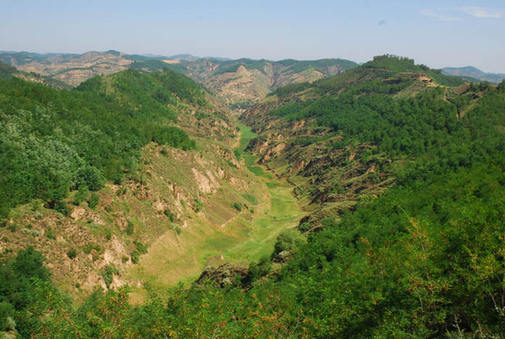Yan'an: Red Capital, Green Revolution
Yan'an: Red Capital, Green Revolution
By staff reporter LI WUZHOU
YAN'AN on the Loess Plateau is known as the red cradle of the Chinese Revolution. It was here, from 1935 to 1947, that the Central Committee of the Chinese Communist Party and Mao Zedong directed the resistance against the Japanese invasion behind enemy lines and fought the Liberation War against the reactionary rule of the Kuomintang, laying a solid foundation for the People's Republic of China.
Yan'an also paid a heavy price for being the "war room" of the Chinese Revolution. At that time it was a small county seat with a population of 30,000, but over 100,000 Communist-led troops were stationed here in those days. Under the blockade mounted by Japanese invaders and the Kuomintang, a desperate shortage of grain threatened their survival. The Communist leaders launched a production campaign: troops burned the forests to plant grain crops and a famine was largely avoided, but forest coverage was decimated. In the 1960s, the population reclaimed mountains to grow crops, fueling the deterioration of local ecology. Yan'an became one of the areas that suffered from heavy soil erosion – 77.8 percent of its total area was like an earthy skin that would peel off with every heavy rainfall, and its gullies would be choked with mud as in the aftermath of a flood.
 |
|
Vegetation coverage has recovered since implementing the policy of returning farmland to forests. |
But great changes have swept over Yan'an. Terraced fields on the mountain slopes have been fortified by trees. The mountains have a green coat again and its waters are clear and flowing.
The policy of converting farmland back to forest started in the late 20th century. While developing the economy especially in the western regions, the Chinese government noticed the deterioration of local environments, and put forward a plan for recovery. This plan was first put into effect in Yan'an, and in the 12 years from 1999 to 2010, more than 600,000 hectares were restored to nature. According to the remote sensing satellite data collected by the Forestry Department of Shaanxi Province the basic tone of the Loess Plateau (of which Yan'an makes up half) has turned from yellow to green in just over a decade. The green area extends 400 kilometers northward of Yan'an. The annual rainfall has increased by 20 percent (up more than 100 mm over figures from a decade or so ago). The silt which usually rushed into the Yellow River from Yan'an has decreased nearly by half in the same time period. There are no local sandstorms anymore; any that sweep across the region come from the Mu Us Desert to the north.
Planting the trees, the Yan'an people drew lessons from past practices and paid attention to biodiversity recovery, instead of planting only one species of tree. They used nature's self-healing capacity to recover related flora.
In little more than 10 years, the red capital Yan'an has turned green. Wuqi County, under its jurisdiction, is the first county in China to implement the policy of returning grain plots to forests, and the area involved is also the largest, and the results are the best.
Services
Economy
- Eco-agriculture and Eco-tourism Power Nanchang’s Green Development
- Balance Environmental Protection and Economic Prosperity – Nanchang Looks to European Technology for Green Development
- Sustainable Growth Requires Wiser Energy Use
- Chinese Economy: On the Path of Scientific Development
- China's Economy over the Last Ten Years

